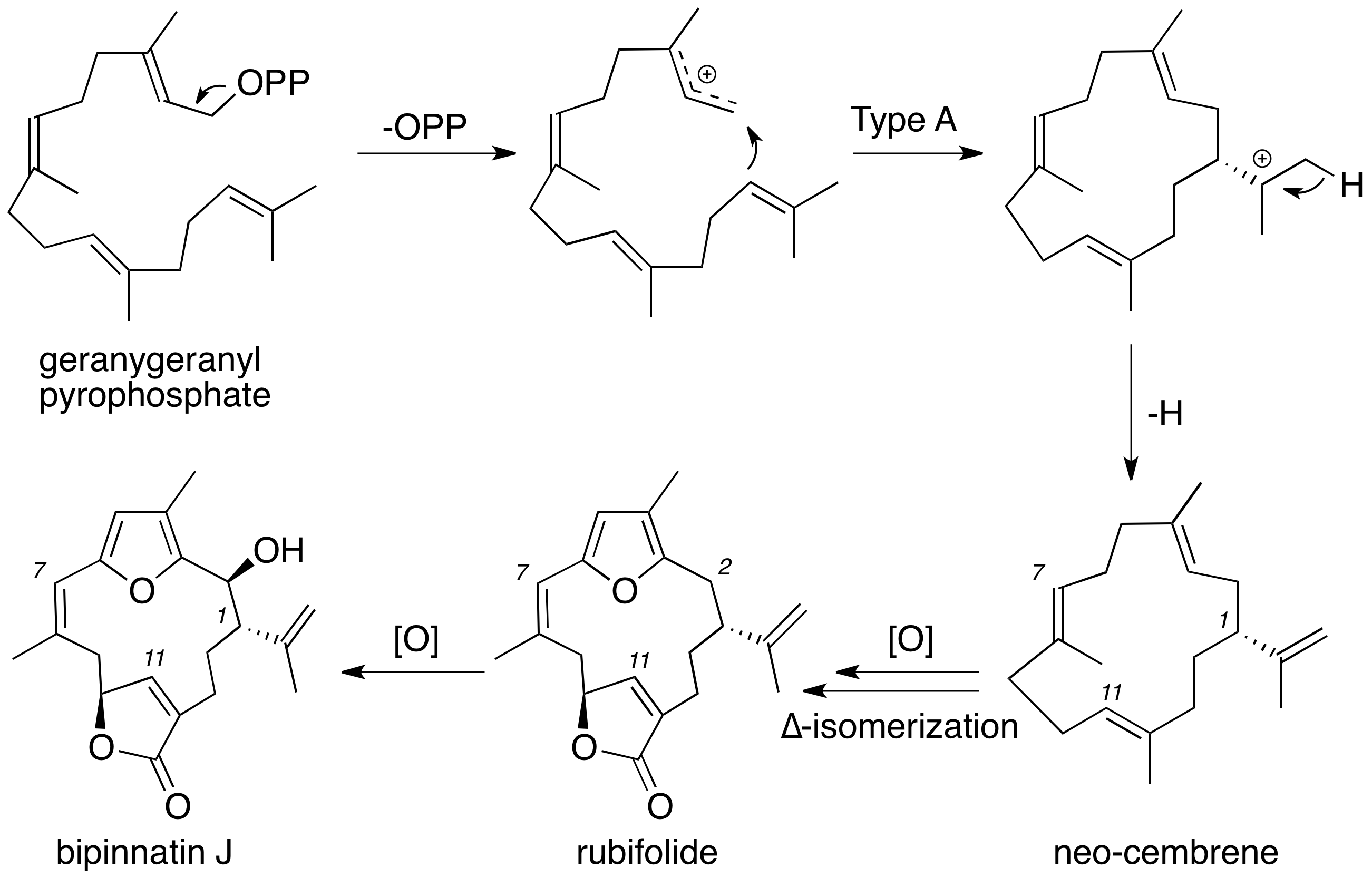|
Bipinnatin J
Bipinnatin J is a diterpene isolated from the bipinnate sea plume ''Antillogorgia bipinnata ''Antillogorgia bipinnata'', the bipinnate sea plume, is a species of Colony (biology), colonial Alcyonacea, soft coral, a Gorgonian, sea fan in the family (biology), family Gorgoniidae. It is found in the Caribbean Sea. It was Species descriptio ...'', a sea fan found in the eastern Caribbean Sea. It is one of the structurally simplest of the furanocembrenolides, and is speculated to be a biosynthetic precursor to a wide array cembrenolides along with the dehydroxylated analog, rubifolide. Biosynthesis Although the exact biosynthesis of bipinnatin J has not been formally studied, the biosynthesis the core cembrane skeleton, neo-cembrene, has been extensively studied. Starting from geranylgeranyl pyrophosphate, the pyrophosphate leaves, creating the allyl carbocation. A type A cyclization then yields the 14-membered cembrane ring with the isopropyl cation outside the ring. Proton elim ... [...More Info...] [...Related Items...] OR: [Wikipedia] [Google] [Baidu] |
Diterpene
Diterpenes are a class of chemical compounds composed of four isoprene units, often with the molecular formula C20H32. They are biosynthesized by plants, animals and fungi via the HMG-CoA reductase pathway, with geranylgeranyl pyrophosphate being a primary intermediate. Diterpenes form the basis for biologically important compounds such as retinol, retinal, and phytol. They are known to be antimicrobial and antiinflammatory. Structures As with most terpenes a huge number of potential structures exists, which may be broadly divided according to the number of rings present. Biosynthesis Diterpenes are derived from the addition of one IPP unit to FPP to form geranylgeranyl-pyrophosphate (GGPP). From GGPP, structural diversity is achieved mainly by two classes of enzymes; the diterpene synthases and cytochromes P450. Several diterpenes are produced by plants and cyanobacteria. GGPP is also the precursor for the synthesis of the phytane by the action of the enzyme geranylger ... [...More Info...] [...Related Items...] OR: [Wikipedia] [Google] [Baidu] |
Antillogorgia Bipinnata
''Antillogorgia bipinnata'', the bipinnate sea plume, is a species of Colony (biology), colonial Alcyonacea, soft coral, a Gorgonian, sea fan in the family (biology), family Gorgoniidae. It is found in the Caribbean Sea. It was Species description, first described as ''Pseudopterogorgia bipinnata '' in 1864 by the American zoologist Addison Emery Verrill. Williams and Chen (2012), transferred all the Atlantic species of ''Pseudopterogorgia'' to ''Antillogorgia. Description ''Antillogorgia bipinnata'' is a colonial soft coral growing in the form of a bipinnate fan usually in a single plane. It can grow to a height of about with a slightly smaller width. It consists of a main stem with several branches, with regularly-spaced pairs of branchlets. The branchlets are stiff, slightly flattened, and typically long and in diameter. They are spaced about apart and project at an angle of about 65° from the branch. The apertures from which the polyps protrude are small and slit-like and ... [...More Info...] [...Related Items...] OR: [Wikipedia] [Google] [Baidu] |
Neo-cembrene
Cembrene A, or sometimes neocembrene, is a natural monocyclic diterpene isolated from corals of the genus '' Nephthea''. It is a colorless oil with a faint wax-like odor. Cembrene A itself has little importance as a chemical entity, being a trail pheromone for termites; however, the chemical structure of cembrene is central to a very wide variety of other natural products found both in plants and in animals.''Terpenes: Flavors, Fragrances, Pharmaca, Pheromones'', Eberhard Breitmaier, page 7. Cembrenes are biosynthesized by macrocyclization Macrocycles are often described as molecules and ions containing a ring of twelve or more atoms. Classical examples include the crown ethers, calixarenes, porphyrins, and cyclodextrins. Macrocycles describe a large, mature area of chemistry. ... of geranylgeranyl pyrophosphate. References {{reflist Diterpenes Alkene derivatives Insect ecology Insect pheromones Cycloalkenes ... [...More Info...] [...Related Items...] OR: [Wikipedia] [Google] [Baidu] |
Geranylgeranyl Pyrophosphate
Geranylgeranyl pyrophosphate is an intermediate in the biosynthesis of diterpenes and diterpenoids. It is also the precursor to carotenoids, gibberellins, tocopherols, and chlorophylls. It is also a precursor to geranylgeranylated proteins, which is its primary use in human cells. It is formed from farnesyl pyrophosphate by the addition of an isoprene unit from isopentenyl pyrophosphate. In ''Drosophila'', geranylgeranyl pyrophosphate is synthesised by HMG-CoA encoded by the Columbus gene. Geranylgeranyl pyrophosphate is utilised as a chemoattractant for migrating germ cells that have traversed the midgut epithelia. The attractant signal is produced at the gonadal precursors, directing the germ cells to these sites, where they will differentiate into eggs and spermatozoa (sperm). Related compounds * Farnesyl pyrophosphate * Geranylgeraniol * Geranyl pyrophosphate Geranyl pyrophosphate (GPP), also known as geranyl diphosphate (GDP), is the pyrophosphate ester of the terpenoi ... [...More Info...] [...Related Items...] OR: [Wikipedia] [Google] [Baidu] |

